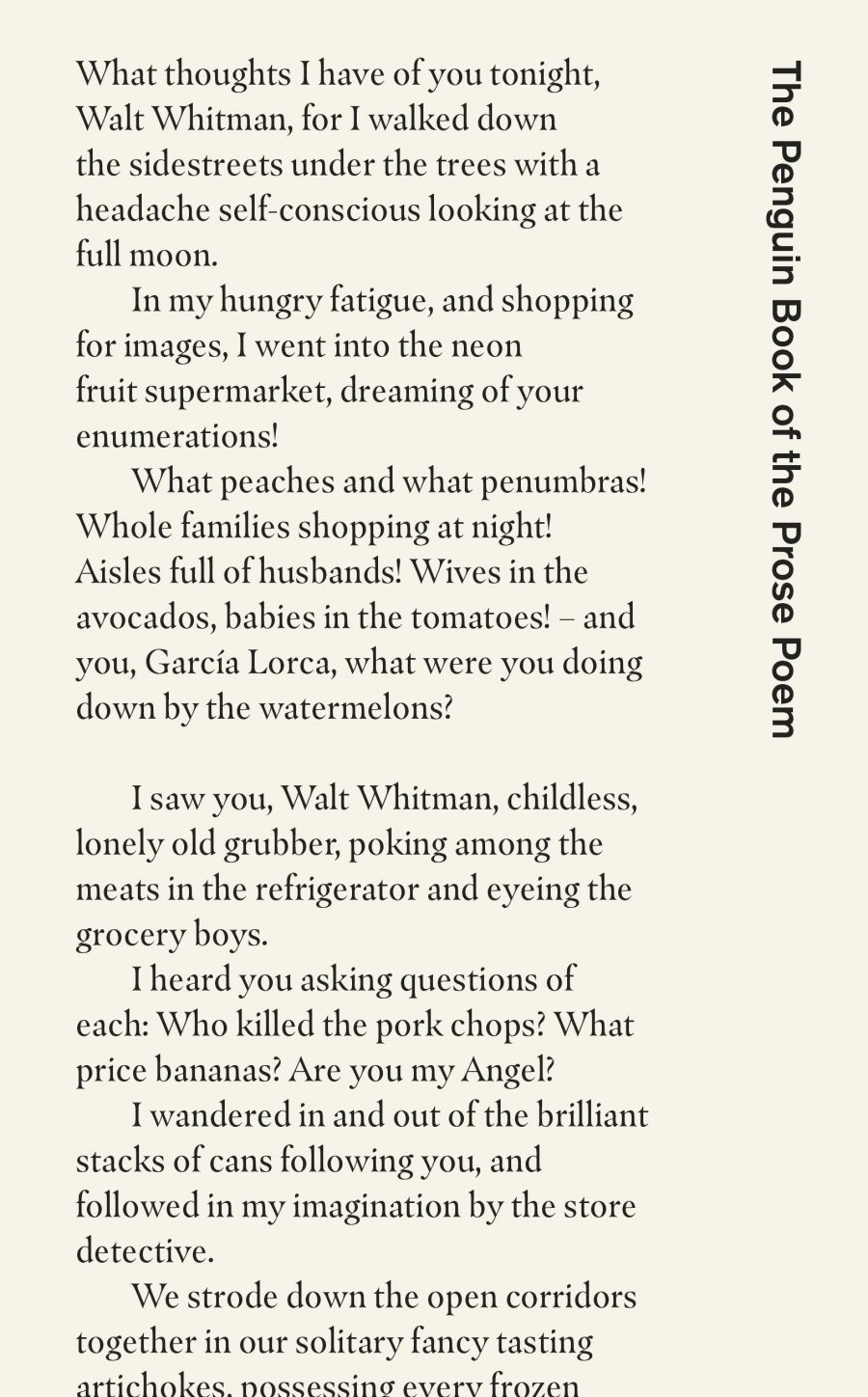
- Free Article: No
- Contents Category: Poetry
- Review Article: Yes
- Online Only: No
- Custom Highlight Text:
In his infamous 1955 review of Patrick White’s The Tree of Man, A.D. Hope’s dismissal of the book as ‘illiterate verbal sludge’ focuses on a perceived confusion between the categories of poetry and prose. White ‘tries to write a novel as if he were writing poetry, and lyric poetry at that’, writes Hope ...
- Grid Image (300px * 250px):

- Alt Tag (Grid Image): John Hawke reviews <em>The Penguin Book of the Prose Poem</em> by Jeremy Noel-Tod
- Book 1 Title: The Penguin Book of the Prose Poem
- Book 1 Biblio: Penguin Classics, $69.99 hb, 480 pp, 9780241285794
At the centre of this re-evaluation is an acknowledgment that the accepted distinctions between poetry and prose cannot be so easily restricted: Hope’s formulation would eliminate the novels of Joyce, Woolf, and Beckett, as well as such dense examples as José Lezama Lima’s Paradise (1966) and Gabriel García Márquez’s The Autumn of the Patriarch (1975). As Ron Silliman points out in The New Sentence, his seminal 1977 study, prose and poetry are best regarded as a ‘continuous spectrum’, since ultimately ‘all writing is a mixed mode’: there is only the art of language. The introduction to this volume explains that this recognition can be traced back at least as far as Wordsworth, but certainly came into currency, along with the prose poem itself, with the inception of Modernist practice toward the end of the nineteenth century. For Stéphane Mallarmé, the crucial distinction is between stylised literary language and ordinary speech, or more expository writing denigrated as ‘journalism’. Critics who emerged from within the literary avant-garde, such as Roman Jakobson, assert a broader definition of ‘literariness’ that is inclusive of both metrical verse and literary experiments in prose. Perhaps the central figure within this volume is the American Cubist poet Gertrude Stein, whose question, ‘What is poetry and if you know what poetry is what is prose?’ is cited as an epigraph. Her melodic incantations, resisting the usual descriptive functions of words, are definitively ‘poetic’ despite their appearance as prose.
 Gertrude Stein at her salon, 1920 (photograph via the Gertrude Stein and Alice B. Toklas Estate)
Gertrude Stein at her salon, 1920 (photograph via the Gertrude Stein and Alice B. Toklas Estate)
Although Noel-Tod describes her as ‘the most original prose poet in the English language’, Stein provides an extreme example, pushing language to the verge of abstraction and deliberately evading direct communication. In sacrificing the prosodic resources of traditional verse, prose poetry instead foregrounds a range of alternative poetic devices, making it impossible to define in any generalised way. The more influential model here is Rimbaud’s poems in Illuminations, with their collage-like juxtaposition of elements, denying the linearity of narrative; and their striking conjunctions of synaesthesic imagery, which would particularly influence the Surrealists. Rimbaud’s ‘After the Flood’ provides the cover illustration for this volume – and it appears in translation by John Ashbery, one of his main inheritors from the ‘second wave’ of poetic experimentation.
The strictly chronological arrangement of Noel-Tod’s selection invites an historical reading and provides an opportunity to trace modern poetics to its sources. The form is first given shape against a background of urban modernity in Baudelaire’s Le Spleen de Paris (1869): he is followed by other nineteenth-century French Symbolists, such as Mallarmé and Rimbaud, as well as by their English aestheticist counterparts, Oscar Wilde and Ernest Dowson. Avant-garde Modernism appears with the Russian Futurist Velimir Khlebnikov in his 1911 work, ‘Zoo’. His international equivalents are Stein, whose Tender Buttons appears in 1914, and Parisians associated with the Cubist painters, such as Pierre Reverdy and Max Jacob. William Carlos Williams, whose key influences were both Stein and Apollinaire’s essays on Cubism, is represented here by an excerpt from Kora in Hell, a work that shifts assuredly between prose and free verse.
Surrealism emerges in the 1920s through the collaborative automatist experiments of André Breton, Philippe Soupault, and Paul Éluard, and aspects of the surrealist approach are evident across many examples of the form. This includes particularly the infectious absurdism of Henri Michaux, whose work appears here alongside the previously mentioned Auden (a surrealist incongruity). It can also be seen in the defamiliarising approach to ordinary objects of Francis Ponge, whose writings strongly informed a certain strand of postwar American poetry. The widespread proliferation of these influences across European languages is exemplified in the work of such far-flung poets as the Peruvian Cesar Vallejo and the Martinican Aimé Cesaire, whose work extends Surrealism to issues of colonialism.
Octavio Paz has noted that the innovations of this period only emerge in Anglo-American poetry in the 1950s, through the ‘cool’ surrealist approach of Frank O’Hara and Ashbery, and in the Beats adoption of the declamatory style of Vladimir Mayakovsky and Blaise Cendrars. This second wave of experimentation demarcates what Noel-Tod terms ‘The Postmodern Prose Poem’, a period which sees a broadening of the international modernist style, and the influence of translation on practitioners such as Robert Bly and the Michauxian Russell Edson. The model of Stein is recovered and celebrated in the 1970s through the procedural works of poets such as Bernadette Mayer and Lyn Hejinian. And at this point we find Australian responses: Laurie Duggan’s objectivist found poetry; the fabulism of joanne burns; and Pam Brown’s nouveau roman observational poetry.
This projects naturally into the selection of twenty-first-century examples: Noel-Tod includes familiar names such as Anne Carson and Claudia Rankine alongside such outliers and radicals as Keston Sutherland and Sean Bonney, in what is naturally the most contestable section of his volume. One can’t help thinking of local examples that would stand up just as well – Peter Boyle, Philip Hammial, Anna Couani, and Ania Walwicz are some of our leading practitioners in this field – but the terms of this anthology are unfailingly inviting and inclusive.


Comments powered by CComment